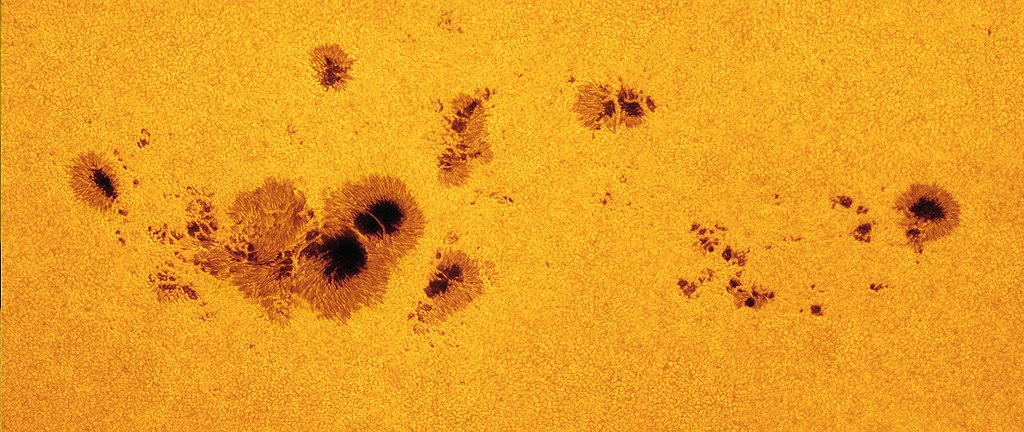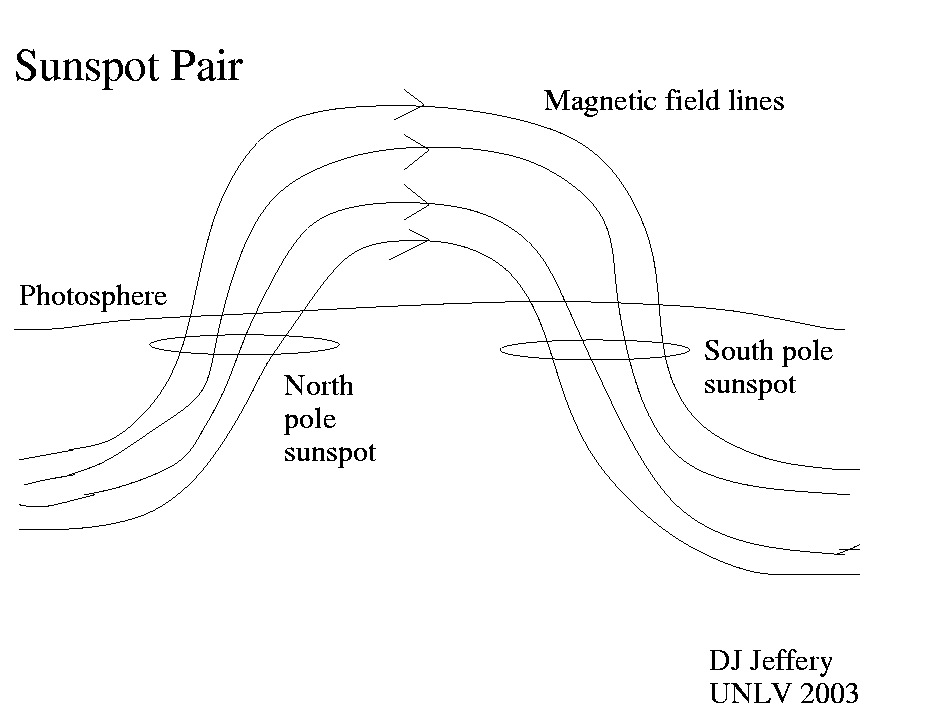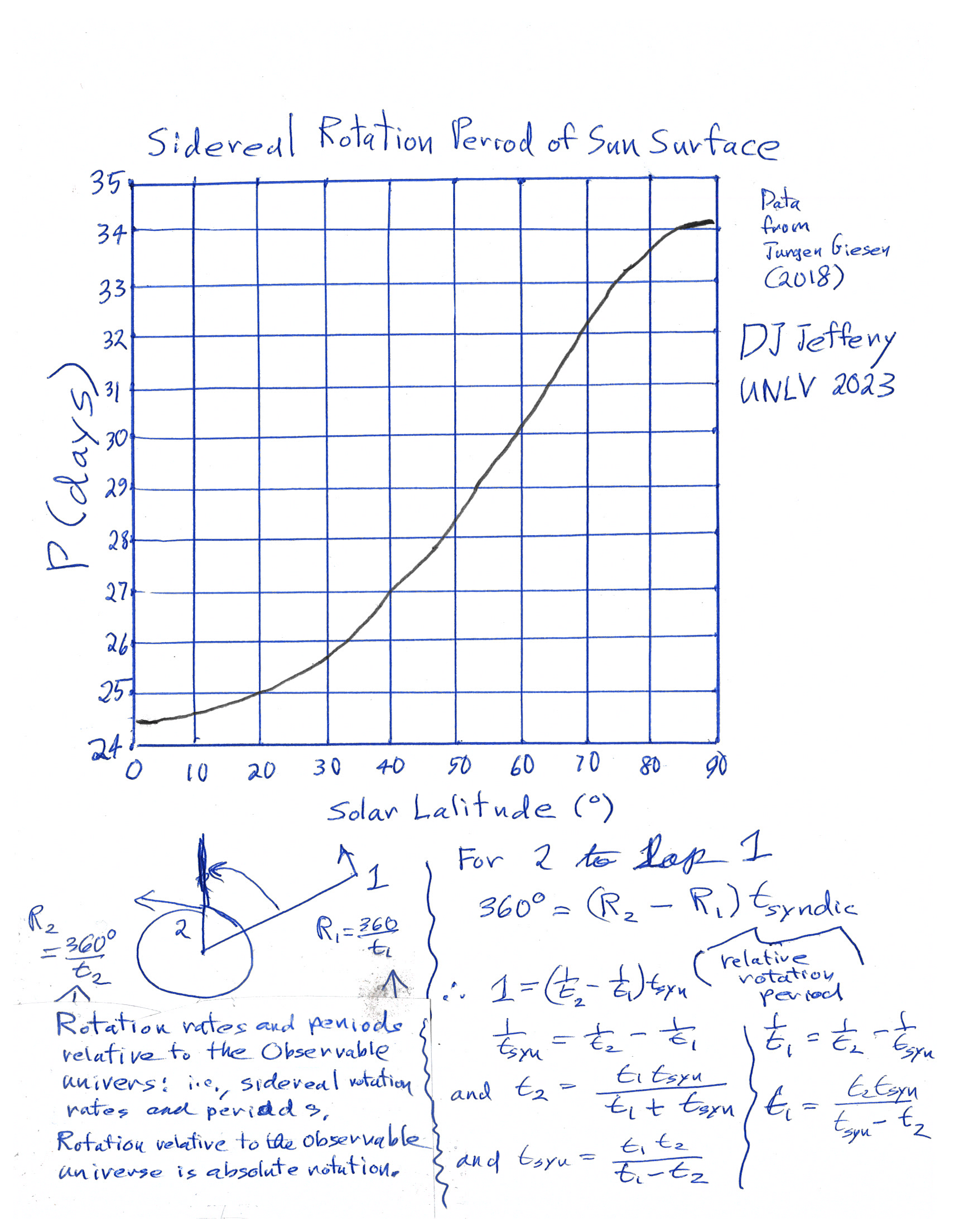
Image 1 Caption: A group of sunspots (i.e., a sunspot group (a few to ∼100 sunspots), in designated solar Active Region 1520) rotated into view over the east (i.e., left) limb of the Sun on 2012 Jul07. The large sunspot on the left extends more than 11 Earth diameters (∼ 130,000 km). The complete chain of sunspots extends ∼ 320,000 km.
Features:
- In Image 1
off the sunspots,
one can see the
solar granulation.
The granules
are the tops of hot convection cells.
They break up in about 10 minutes and have a size scale
of ∼1000 km
(Cox-364;
Se-148).
Between the granules, the gas sinks in intergranular lanes (see also Froelich et al. 1998: intergranular lanes).
- Sunspots are
a part of
solar phenomena (Sun weather).
They were discovered in 1610 or soon thereafter independently by several early telescopic era astronomers (1608--1700). including Galileo (1564--1642) though he was NOT the first (see Wikipedia: Sunspots: History; Wikipedia: Solar observations: 17th and 18th centuries).
- Sunspots in brief description:
- Sunspots
are somewhat colder (∼ 4000 K at their centers) than the
surrounding photosphere
(∼ 5800 K), and so they radiate less intensely than the
surrounding photosphere
as prescribed by the
Stefan-Boltzmann law
of blackbody radiation
(Se-155).
In images which scales down all
intensity equally
(like the one shown) they therefore appear relatively dark.
- The dark inner region of a
sunspot is called the
sunspot umbra and
the less dark border the sunspot penumbra.
Note sunspot
"umbra" and "penumbra" are a different usage of
those words than what occurs for
eclipse phenomena
(see
Wikipedia: Umbra, penumbra,
and antumbra).
- Sunspots
are typically 10000's
of kilometers in size scale
and are typically about twice the
Earth's diameter (mean value 12,756.2 km)
(Ni-123;
Se-154).
- Sunspots are transient and may last anywhere from a few
days to a few
months
(Wikipedia: Sunspots: Lifecycle).
- Image 2 Caption: The surface solar sidereal rotation period (i.e., the rotation period relative to the observable universe) as a function of solar latitude. The solar surface and interior show differential rotation since the Sun is NOT a solid anywhere, unlike the Earth which has some solid layers. For more details, see Sun file: solar_rotation.html.
- Sunspots are used to to determine the surface solar rotation rate. This was first done by early telescopic era astronomers (1608--1700) including Galileo (1564--1642) (see Wikipedia: Solar rotation: Using sunspots to measure rotation.
- Sunspots tend to occur in sunspot groups (a few to ∼100 sunspots) that can persist for weeks to months (Wikipedia: Sunspots: Lifecycle). The sunspot groups have associated solar active regions (regions of strong and complex magnetic field).
- Sunspots are regions where magnetic field lines emerge or plunge in the solar photosphere. So sunspots are essentially a magnetic phenomenon.
In fact, the emergence and plungence of a pair of sunspots are often close together, and so sunspots often come in sunspot pairs. One member of the pair is a north pole and the other a south pole.
The comparative coldness of sunspots is because their strong magnetic fields suppress convection that is otherwise heating the solar photosphere (see Wikipedia: Sunspot: Formation).

- Image 3 Caption: A cartoon of a pair of sunspots illustrating their magnetic field and their north pole and south pole states.
- Image 2 Caption: The surface solar sidereal rotation period (i.e., the rotation period relative to the observable universe) as a function of solar latitude. The solar surface and interior show differential rotation since the Sun is NOT a solid anywhere, unlike the Earth which has some solid layers. For more details, see Sun file: solar_rotation.html.
- Sunspots
are somewhat colder (∼ 4000 K at their centers) than the
surrounding photosphere
(∼ 5800 K), and so they radiate less intensely than the
surrounding photosphere
as prescribed by the
Stefan-Boltzmann law
of blackbody radiation
(Se-155).
In images which scales down all
intensity equally
(like the one shown) they therefore appear relatively dark.
- See also
Sun keywords below
(local link /
general link: keywords_sun.html):
- EOF
- Solar atmosphere videos below (local link / general link: solar_atmosphere_videos.html):
-
Images:
- Credit/Permission:
Alan Friedman,
NASA,
2012
(uploaded to Wikimedia Commons
by User:Werieth,
2012) /
Public domain.
Image link: Wikimedia Commons: File:Solar Archipelago - Flickr - NASA Goddard Photo and Video.jpg.
- Credit/Permission: © David Jeffery,
2023 /
Own work.
Image link: Itself.
Data source: Jurgen Giesen, 2018. See Jurgen Giesen: Solar Rotation Applet and Jurgen Giesen: Sidereal Rotation Period of the Sun (days).
- Credit/Permission: ©
David Jeffery,
2003 / Own work.
Image link: Itself.
File: Sun file: sunspots_intro.html.
